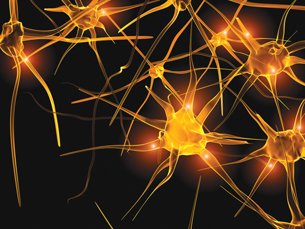Module 1
1. Module 1
1.52. Lesson 8
Module 1—The Nervous System
Lesson 8—Synaptic and Neuromuscular Transmission—Crossing the Divide
 Get Focused
Get Focused

© Monika Wisniewska/shutterstock
You hear laughter from just behind you. You turn and your eyes meet those of the new girl you were introduced to earlier in the night. She smiles and asks, “Do you know the time?” What will you say? You are so nervous! Will a response even come out of your mouth? Thank goodness your nervous system is working, and you are able to stutter out the time.
Your nervous system is responsible for the communication between this person and yourself. Up to this point, you have learned about neurons and you are aware of the synaptic gaps, the tiny spaces between neurons. Communication usually requires some sort of “connection.” Think about what happens when the phone lines are down or your Internet connection doesn’t work. You know what it’s like when there are gaps in these communication pathways. When your phone and the Internet won’t work, there’s no “connection” to complete the communication pathway between you and the outside world!
In your nervous system, how do sights and sounds get communicated from neuron to neuron and across the synaptic gap between them? In most forms of communication, these incomplete connections would mean a communication “shut down,” but your nervous system is amazing! It has a unique way of completing the connection across the synaptic gap.
This lesson is about the events that occur in the synaptic gap. You will examine how neurons communicate with each other and with muscles. When scientists understood the events at the synaptic gap, technologies were developed to control and modify the communication of nerve transmissions. The events at the synaptic gap can be affected by many substances, such as coffee, energy drinks, alcohol, and anesthetics. They can also be affected by disorders such as Parkinson’s disease and Alzheimer’s disease.

left: © Dmitry Sunagatov/3409070/Fotolia; middle: © VR Photos/shutterstock; right: © VanHart/shutterstock
In this lesson you will investigate the following focusing questions:
- How does the anatomy and function of the synaptic gap and neuromuscular junction facilitate the transmission of nerve impulses between neurons and between neurons and effectors?
- How do chemicals taken into the body and disorders, such as Parkinson’s disease, compromise synaptic transmission?
 Module 1: Lesson 8 Assignment
Module 1: Lesson 8 Assignment
Your teacher-marked Module 1: Lesson 8 Assignment requires that you complete and submit the following:
- Part 1—Drug Research
- Part 2—the Synaptic Gap
Download a copy of the Module 1: Lesson 8 Assignment to your computer now. You will receive further instructions about how to complete this assignment later in the lesson.
You must decide what to do with the questions that are not marked by the teacher.
Remember that these questions provide you with the practice and feedback that you need to successfully complete this course. You should respond to all the questions and place those answers in your course folder.
During this lesson, you will continue to develop your Module Assessment project by researching the relationship between Alzheimer’s disease and the events at the synaptic gap. As this is the last lesson in this module, you will have an opportunity to assemble all of your Module Assessment work and submit it for assessment. Your completed Module Assessment will be due at the end of this lesson.
You will also continue to add all your answers to questions, activities, and reflections to your course folder for later review and study. Research into Parkinson’s disease, curare, botulism, the characteristics of neurotransmitters, and the neural synapse will also be filed in your course folder.
Remember that further practice and application can be completed by completing questions in the textbook. The questions on pages 402 and 403 and pages 432 and 433 provide an excellent review of the material in this module. You may wish to answer these questions before you attempt the Module Assessment. You can access the answers to these questions and get feedback about your answers from your teacher. The Key and The Study Guide for Biology 30 provide you with many Diploma Exam-style multiple-choice, numerical-response, and written-response questions that will provide excellent review of the module and prove to be good preparation for the Diploma Exam.